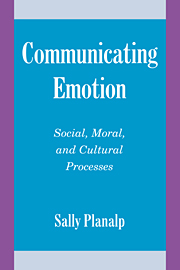Book contents
- Frontmatter
- Dedication
- Contents
- Acknowledgments
- Introduction
- 1 How Important Is Emotion in Everyday Interaction?
- 2 How and Why Is Emotion Communicated?
- 3 Is Emotional Communication Spontaneous or Strategic?
- 4 How Is Emotional Meaning Constructed Through Communication?
- 5 How Is Emotional Meaning Both Personal and Social?
- 6 How Do Emotion Messages Communicate Moral Meaning?
- 7 How Is Emotional Communication Grounded in Common Human Experience and Diverse Cultures?
- Epilogue: What is the Future of Emotional Meaning?
- References
- Author Index
- Subject Index
6 - How Do Emotion Messages Communicate Moral Meaning?
Published online by Cambridge University Press: 05 February 2015
- Frontmatter
- Dedication
- Contents
- Acknowledgments
- Introduction
- 1 How Important Is Emotion in Everyday Interaction?
- 2 How and Why Is Emotion Communicated?
- 3 Is Emotional Communication Spontaneous or Strategic?
- 4 How Is Emotional Meaning Constructed Through Communication?
- 5 How Is Emotional Meaning Both Personal and Social?
- 6 How Do Emotion Messages Communicate Moral Meaning?
- 7 How Is Emotional Communication Grounded in Common Human Experience and Diverse Cultures?
- Epilogue: What is the Future of Emotional Meaning?
- References
- Author Index
- Subject Index
Summary
In emotion, we see values as virtual facts of the world.
Cochran and Claspell (1987: 159)One of the most emotionally powerful photographs in recent years is of a firefighter carrying the bleeding body of a toddler from the wreckage of the bombed federal building in Oklahoma City. Through the photo, we felt the anguish and despair of the people who loved that child, of the firefighter and other rescue workers who were carrying out the victims, and of all our fellow human beings who were affected by the tragedy. And we wanted to do something about it - to rush to the aid of the victims (as many people did), to find and punish the bomber, and to make sure that this sort of tragedy could never happen again. Our emotions tell us that the world is not as it should be and that we should do something about it. Imagine another image of children dancing and playing on a beach. We feel their exuberance, their joy, their sense of being alive, their connections with one another. We know through our feelings that the world is as it should be, that we should appreciate the perfection of that moment, and that we should try to sustain the kind of world that produces such joy and love.
When we sift through the complexities, we find that messages loaded with emotion have two essential meanings: a judgment of good or bad and an imperative to keep things as they are or to change things. This is the core of emotional theory, as described earlier. The two key components of the emotional process are appraising the situation (and the most basic appraisal is good/bad) and a tendency to act or refrain from action (Frijda et al., 1989). Anger stems from the judgment that something is wrong (often unjust) and that action should be taken to fix it. Love stems from the judgment that something is right and that action should be taken to sustain it. In two words: emotion orients us to the good and to the should: to things that we value and to things that we feel we ought to do.
- Type
- Chapter
- Information
- Communicating EmotionSocial, Moral, and Cultural Processes, pp. 160 - 193Publisher: Cambridge University PressPrint publication year: 1999

